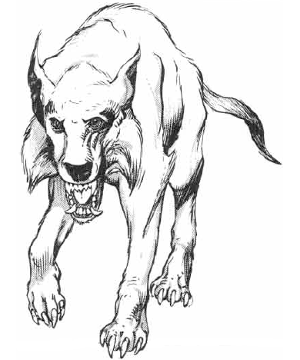

2107

| Climate/Terrain: | Any/Mountains or hilly forests |
|---|---|
| Frequency: | Rare |
| Organization: | Pack |
| Activity Cycle: | Any |
| Diet: | Carnivore |
| Intelligence: | Low (5-7) |
| Treasure: | C |
| Alignment: | Chaotic neutral |
| No. Appearing: | 1-10 |
| Armor Class: | 5 |
| Movement: | 18 |
| Hit Dice: | 5-8 |
| THAC0: | 5-6 HD: 15 7-8 HD: 13 |
| No. of Attacks: | 1 |
| Damage/Attack: | 1-12 |
| Special Attacks: | Stunning howl, paw rake |
| Special Defenses: | Nil |
| Magic Resistance: | Nil |
| Size: | L (6-9’ long) |
| Morale: | Elite (13-14) |
| XP Value: | 5 HD: 270 6 HD: 420 7 HD: 650 8 HD: 975 |
The tyrg is a cross between a dog (in watchfulness) and a tiger (in stalking ability).
A tyrg stands three feet tall at the shoulder and varies in length from six to nine feet. Its overall coloring is white with gray, black, and tan splotches. The tyrg’s sleek stance while hunting is reminiscent of a cat, but its powerful jaws, containing many fangs, demonstrates its relation to the world’s dogs.
Combat: When tyrgs engage prey in melee, they emit fierce howls that serve to mildly stun their victims (+2 penalty to initiative, -2 penalty to attack rolls) for the following three rounds. There is no saving throw for these howls. Note that the effects of this stunning are not cumulative, and only after the first three rounds of stunning have worn off can those affected be stunned again. After howling, tyrgs attack. Their powerful jaws full of massive teeth cause 1d12 points of damage with every vicious bite. If an opponent is overborne, or otherwise finds himself prone on the ground, the tyrg’s raking forepaws can inflict 1d4 points each on the already besieged victim.
Tyrgs can move silently 75% of the time and are surprised only on a roll of 1 due to their superior senses.
Habitat/Society: Little is known about tyrgs, as they have been encountered only relatively recently. What has been gathered has been from wholly unreliable observation carried out by completely inexperienced information gatherers (i.e., adventurers). Tyrgs have been reportedly sighted in roving packs, leading one to believe they lean heavily to the wild dog branch of their ancestry. However, the few lairs that have been breached successfully tend to support the idea that the female tyrgs do the majority of the hunting. This observation tends to suggest the pride-like nature of tigers and lions.
Combining the two observations is difficult, but a suitable hypothesis has been proposed. Pending verification by trustworthy sources, it is believed that tyrgs travel in roving, almost nomadic, packs across the wilderness. Every few seasons, or perhaps years, the current lair is abandoned, and the pack moves on (under the leading male’s guidance). However, when the pack is stationary, having chosen a suitable lair, the tyrgs settle back and form a new pride.
Females, after giving birth to their young, forage out to seek food. The males remain behind, guarding the lair and the young, and proceeding to test the strength and power of the other males, thereby reestablishing or reorganizing the ruling hierarchy.
If tyrgs are encountered in their lair (usually a cave or deep hole in the ground), there are 1d4 young present (20-70% grown). These fight with the adults to preserve the lair. All others in the lair are adults.
Ecology: It is important to note that the sexes cannot yet be told apart from afar, because of a lack of general knowledge regarding these hounds. Coloration notes or behavioral anecdotes might provide a clue.
Otherwise, tyrgs are straight-forward predatory carnivores. They have no natural enemies, other than monsters even nastier and hungrier than they are, and have no natural allies. Even related species, like wild dogs and tigers, are dealt with on a case-by-case basis, meaning that sometimes they are greeted, sometimes they are attacked. Again, no obvious behavioral patterns have been observed.

◆ 1874 ◆